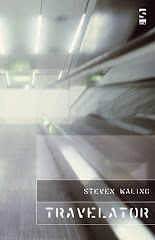
The final event of the text festival was all to do with Kurt Schwitters. First, there was a seminar in which people who had performed or responded to his sound-poem Ursonate talked about it, and we saw pictures of the Merzbarn in Ambleside, one of his last remarkable works. I learned something that I had never known about Bury: that for a short time, Schwitters had been interned in Bury at an old mill called Warth Mill, as an enemy alien, before going off to the Isle of Man where many European artists, thinkers and writers were sent before the British Government recognised that they weren't Nazi spies.
This strange connection of Bury to European art and the Entarte Kunst (Degenerate Art) that Hitler was so against made for a remarkable performance of the whole of the Ursonate in the basement of this mill. It was dark: there were candles, one anglepoise lamp and the light from mobile phones to illuminate the text for the four readers. We were inside a space with plaster peeling from old red-brick walls, lots of bare central heating pipes and a picture of the man himself at th front.
And what a remarkable piece it is: full of rolling 'r's', labial 'l's', 'k's' and in amongst this the structure of a sonata, including a rondo, a scherzo, a beautiful largo and a cadenza. The readers included Christian Bok, himself a remarkable experimental poet whose pieces in the Text Festival include a poem programmed into the DNA of a bacillus, and Jaap Blonk, himself a sound poet and musician of considerable achievement.
I left the dark of that room into the brilliant sun shining onto the tarmac a very ordinary industrial estate in a very ordinay part of a very ordinary town in North East Lancashire, reflecting on connections. The connection between Bury and international modernism, as seen both in this performance and in the text festival itself, is all the more remarkable for being so unexpected. It's almost like one of Kurt Schwitter's Merz collages: ordinary materials transformed into the extraordinary. Which is how one of the participants of the Schwitters seminar described as the purpose of art: to take bits of the world, treat it and return it back to the world transformed.

No comments:
Post a Comment